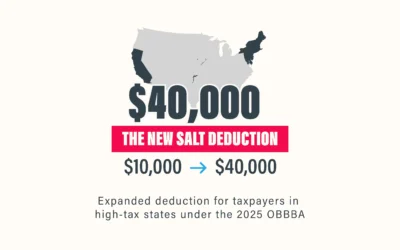When selling investment real estate, one of the biggest concerns for investors is the tax bill. Between capital gains, depreciation recapture, and state taxes, a large portion of your profit can quickly be eroded. Fortunately, the IRS provides a tool that allows you to defer taxes and keep your money working for you, known as the the 1031 exchange.
What Is a 1031 Exchange?
A 1031 exchange, named after Section 1031 of the Internal Revenue Code, allows real estate investors to defer paying taxes when selling an investment property, as long as the proceeds are reinvested into another “like-kind” property.
This doesn’t eliminate the tax forever, but it does allow you to roll your gains forward and keep building wealth with a larger pool of capital. Investors often use multiple 1031 exchanges over their lifetime, creating significant long-term growth before eventually cashing out. Some really savvy investors will actually plan to have those deferred taxes pass through their estate upon their death which is one of the few legal ways to avoid paying Uncle Sam.
The Benefits of a 1031 Exchange
The main advantage of a 1031 exchange is deferral of taxes, but there are other key benefits:
- Preserve more capital: Instead of losing 20 to 30% of your profit to taxes right away, you can reinvest the full amount into your next property.
- Portfolio growth: Larger reinvestments mean the opportunity to buy bigger, higher-income-producing properties.
- Flexibility in strategy: Investors can consolidate smaller properties into one larger property, or diversify by swapping one property for multiple assets.
- Estate planning benefits: If an investor continues exchanging until death, heirs may receive a stepped-up basis, potentially wiping out deferred gains altogether.
Key Rules and Requirements
- Equal or greater investment: To fully defer taxes, the new property must be of equal or greater value than the property sold. Pay close attention to this point…it is based on the sale price of the property you are selling, not what you paid for it originally. In addition, all equity and debt must be reinvested. If you take cash out or reduce debt, those amounts (called “boot”) are taxable to you.
- Like-kind property: The definition of “like-kind” is broad. You can exchange an office building for an apartment complex, raw land for a warehouse, or retail space for a self-storage facility.
- Use of a Qualified Intermediary (QI): You cannot receive the proceeds of the sale directly. A QI must hold and transfer the funds.
- Strict timelines:
- 45-day identification period: You must identify potential replacement properties within 45 days of the sale.
- 180-day completion window: The exchange must be fully completed within 180 days.
- Investment or business use only: Both the old and new properties must be hel for investment or business purposes.
Failure to meet these requirements can invalidate the exchange, resulting in immediate taxation.
Improvement Exchanges: 1031s for Renovation Properties
A lesser-known variation of the 1031 exchange is the improvement exchange (also called a “build-to-suit exchange”). This strategy allows investors to reinvest sale proceeds not just into buying a property, but also into improving or renovating it.
Here’s how it works:
- Suppose you sell a property and want to reinvest in a new building that needs renovations before it suits your needs.
- Through an improvement exchange, your Qualified Intermediary can use your sale proceeds to fund those renovations.
- As long as the improvements are completed (and the value matches or exceeds the relinquished property) within the 180-day exchange period, the transaction can qualify for 1031 treatment. This means you have to have a rock solid renovation plan and be ready to get working right away.
Improvement exchanges are more complex and require close coordination with tax advisors, intermediaries, and contractors, but they offer flexibility for hands on investors who want to upgrade or reposition their portfolio.
Case Study: Growing Wealth with a 1031 Exchange
Let’s consider an example:
- David owns a small rental property worth $500,000. After depreciation, his adjusted basis is $300,000. Selling outright would generate a $200,000 gain, and he could face over $50,000 in taxes.
- Instead, David uses a 1031 exchange to roll his full $500,000 into a $750,000 multi-family property. He adds a new loan to cover the difference, keeping all $500,000 of his equity at work.
- Over time, the larger property produces higher rental income and greater appreciation. By deferring taxes, David accelerates the growth of his portfolio.
This is the power of a 1031 exchange: it allows investors to trade up, increasing both the size and earning potential of their investments.
Can I borrow against the equity in my 1031 property?
Once the 1031 exchange is complete and you’ve acquired the replacement property, you are the legal owner. At that point, you can typically borrow against the property (for example, with a cash-out refinance or line of credit) without jeopardizing the exchange. The IRS views this as a separate financing transaction, not part of the exchange itself.
This is a common strategy used by investors who want liquidity from their equity while still deferring taxes on the sale.
Pitfalls to Watch Out For
Despite its benefits, a 1031 exchange can be derailed by easy mistakes. Common pitfalls include:
- Missing deadlines: The 45-day and 180-day windows are firm, with no exceptions.
- Improper use of funds: Touching the proceeds directly can invalidate the exchange.
- Under-investing: If you buy a cheaper property or reduce debt, the difference may be taxable as “boot.”
- Mixing personal use: Vacation homes and primary residences generally don’t qualify.
- Complex renovation rules: With improvement exchanges, all work must be completed within the 180-day limit.
When Does a 1031 Exchange Make Sense?
A 1031 exchange can be especially valuable if you are:
- Planning to upgrade into a larger or higher-income property.
- Wanting to diversify into new property types or markets.
- Looking to consolidate multiple smaller properties into one.
- Interested in long-term estate planning strategies.
Because every investor’s situation is different, the decision to pursue a 1031 exchange should always be made with professional guidance.
Final Thoughts
A 1031 exchange is one of the most powerful tools available to real estate investors. By deferring taxes, you can keep more money working for you, upgrade into larger or more profitable properties, and strategically grow your portfolio. With variations like the improvement exchange, the strategy offers even more flexibility for investors looking to reposition or enhance their holdings.
At Southcoast Financial Partners, we help clients evaluate whether a 1031 exchange is the right move for them. If you’re considering selling an investment property, let’s discuss whether a 1031 exchange could help you achieve your goals.


